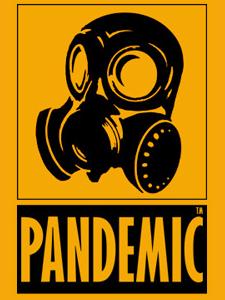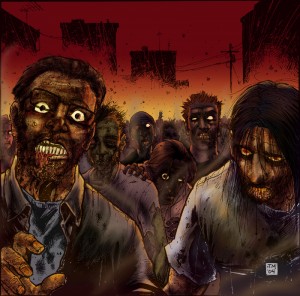Category Archives: Doomsday News
When Zombies invite themself at Bowling- COOLEST THING FOR THE Z-POC
magine play bowling with the head of a zombie as a ball… When Zombies invite themselves at Bowling, a superb campaign for the German version of horror chanel 13th Street, which once again takes up the theme of zombie for its communication (like this previous campaign: Zombies on 13th St
Just when you thought nothing could make bowling any cooler, here come the zombies.

PANDEMIC – Mystery illness in Cambodia solved, doctors say
 Phnom Penh, Cambodia (CNN) — The cause of a mysterious illness that has claimed the lives of more than 60 Cambodian children has been determined, medical doctors familiar with the investigation told CNN on Wednesday.
Phnom Penh, Cambodia (CNN) — The cause of a mysterious illness that has claimed the lives of more than 60 Cambodian children has been determined, medical doctors familiar with the investigation told CNN on Wednesday.
A combination of pathogens, disease-causing micro-organisms, is to blame for the illness, the World Health Organization, in conjunction with the Cambodian Ministry of Health, has concluded, the doctors said.
The pathogens include enterovirus 71, which is known to cause neurological disease; streptococcus suis, which can cause infections like bacterial meningitis in people who have close contact with pigs or with pork products; and dengue, which is transmitted by mosquitoes.
The inappropriate use of steroids, which can suppress the immune system, worsened the illness in a majority of the patients, the doctors said. The World Health Organization (WHO) is expected to advise health care workers to refrain from using steroids in patients with signs and symptoms of the infection, which include severe fever, encephalitis and breathing difficulties.
While not all the microorganisms were present in each patient, doctors concluded the illness was caused by a combination of them and worsened by steroid use.
The WHO sources did not want to be identified because the results of the health organization’s investigation have not yet been made public.
“I’m very confident for the reason of the epidemic,” said Dr. Phillipe Buchy, chief of virology at the Institut Pasteur in Cambodia and one of the doctors who cracked the case.
“The first thing that goes through your mind is, is this one of the usual suspects you haven’t detected before?” said Dr. Arnaud Tarantola, chief of epidemiology and public health at the Institut Pasteur. “If it is, has it mutated, or changed in a way that it causes more severe disease? Or is it something completely new?”
On the steroids issue, Tarantola said, “When you have a dying child, you try to use what you have at hand, and they were right to try that.” But, he acknowledged, “from the cases we reviewed, almost all of the children died, and almost all of them had steroids.”
Parents face anxious wait over mystery illness
“I think we can close the case and move ahead asking different questions,” Buchy said. “Not what is the illness, but now, how long has the virus been circulating? What is the extent of the circulation of the virus? How many mild diseases are we missing? That’s the next step.”
Over the past four months, doctors at Kantha Bopha Children’s Hospitals in Phnom Penh have been faced with the mysterious syndrome, which kills children so fast that nearly all of those infected with it die within a day or two of being admitted to the hospital.
Dr. Beat Richner, head of the children’s hospitals — which cared for 66 patients affected by the illness, 64 of whom died — said that no new cases of the illness had been confirmed since Saturday.
Other hospitals in the country have reported similar cases, but far fewer than the children’s hospitals in the capital, which are the most popular.
In the last hours of their life, the children experienced a “total destruction of the alveola(e) in the lungs,” Richner said. Alveolae are the air sacs where oxygen enters the bloodstream.
Most of the children who have contracted the illness have come from the south of the country, though health officials cannot find what is known as a cluster — a lot of cases coming from one specific area.
By June 29, the WHO had been contacted and Cambodian officials were scrambling to instruct health providers across the country to spread information about the illness as quickly as possible.
Officials search for clues in disease killing Cambodia’s children
The WHO and the Cambodian authorities’ announcement of the situation drew criticism from Richner, who said they were “causing unnecessary panic.”
The WHO said the unexplained nature of the outbreak obliged it to communicate the information.
Over the weekend, lab tests linked enterovirus 71 (EV71) to some of the cases. But the tests didn’t solve the whole puzzle and health officials continued their investigations, noting the detection of other elements like streptococcus suis and dengue.
The link to EV71 does not particularly help in the treatment of the illness, as there is no effective antiviral treatment for severe EV71 infections and no vaccine is available.
In milder cases, EV71 can cause coldlike symptoms, diarrhea and sores on the hands, feet and mouth, according to the journal Genetic Vaccines and Therapy. But more severe cases can cause fluid to accumulate on the brain, resulting in polio-like paralysis and death.
Outbreaks of the enterovirus “occur periodically in the Asia-Pacific region,” according to the CDC. Brunei had its first major outbreak in 2006. China had an outbreak in 2008.
Adults’ well-developed immune systems usually can fend off the virus, but children are vulnerable to it, according to the CDC.
“It looks like (EV71) has emerged strongly, probably because it hadn’t circulated with the same intensity in the past years,” Tarantola said.
Reported cases of streptococcus suis have risen significantly in recent years, notably in Southeast Asia, according to a paper that appeared last year in Emerging Infectious Diseases, a journal published by the Centers for Disease Control and Prevention in Atlanta.
The rainy season in Cambodia, which lasts from May to October, is a key problem in trying to control diseases like dengue. Because of a lack of indoor plumbing in many homes, people collect rainwater in vats, creating potential breeding grounds for mosquitoes.
In Cambodia, as with many places around the world, parents first try treating their child at home. If that doesn’t work, they typically then go to a local clinic. A hospital visit, which often involves a long trip, is a last resort.
Hungry? Try the new zombie diet
One of my favorite episodes of the classic television series “The Twilight Zone” was  titled “To Serve Man.” Aliens visited Earth and proceeded to help humanity solve its social, political and medical problems while setting up an exchange program. A tool was a book with the title of “To Serve Man,” which turned out to be a cookbook with recipes on how to prepare people as meals.
titled “To Serve Man.” Aliens visited Earth and proceeded to help humanity solve its social, political and medical problems while setting up an exchange program. A tool was a book with the title of “To Serve Man,” which turned out to be a cookbook with recipes on how to prepare people as meals.
That imaginative episode of the sci-fi series seems to be playing out in a slightly different form the past two months. Zombie-mania is taking hold of the country, with reports of people eating each other and other creatures.
The entertainment industry is filled with movies and television shows depicting zombies in all of their mindless, flesh-eating gory glory. A cottage industry has tips, products and processes to protect humanity from the living dead.
But zombies aren’t just for entertainment anymore. They have infiltrated real life.
Following the news recently has been a trip through weirdville, with reports on cannibalism and assorted stomach-turning events. Movies, television shows and social media conversations have elevated the topic to near maniacal status, focusing especially on the zombie potential.
One of the first reports came from Miami on May 26, as police shot a naked man eating another man’s face. A few days later, a college student in Maryland told police he killed a man and then ate his heart and part of his brain.
Then things got really weird. In New Jersey, a man stabbed himself 50 times and threw bits of his own intestines at police, who then pepper-sprayed him but still had a hard time bringing him down.
Also in May, police discovered a video that appeared to show Canadian porn performer Luka Magnotta, 29, slashing his bound young lover with an ice pick. He then reportedly abused and dismembered the corpse before eating some of the man’s remains with a knife and fork. Detectives in Montreal allege Magnotta then mailed some body parts to members of the Canadian Parliament. Magnotta was arrested about two weeks later in Germany.
The lunacy continued with other reports in June, including one of a man who ate his dog.
While some are equating the rise of this type of incident to zombies and end-of-the-world prophecies, cooler heads are blaming a more mundane and man-made cause: drug abuse. The New Jersey event is being specifically blamed on a drug mixture known as “bath salts.”
Florida officials describe bath salts as a synthetic drug that reportedly produces “an extreme high of euphoria” and is comparable to amphetamines and cocaine. The mixture is sold as potpourri and incense at liquor stores, gas stations and head shops. Officials said in order to know exactly what is in each package you have to seize them from the store and test them in a lab.
Some state legislatures, Michigan included, have taken steps to outlaw the product. The federal Centers for Disease Control and Prevention in Atlanta released a statement saying there is no Zombie Apocalypse on the horizon.
Personally, I think the CDC’s statement is just a diversion to hide the truth.
In the meantime, bolt the doors, stockpile the food and keep your loaded weapons nearby. Remember, zombies are already dead. The only way they can be stopped is by destroying the brain, according to people who have studied this sort of thing.
PANDEMIC OUTBREAK – Mystery illness claims dozens of Cambodian children
 Hong Kong (CNN) — The World Health Organization is helping the Cambodian Ministry of Health investigate the cause of a mysterious illness that has killed dozens of children in the country since April.
Hong Kong (CNN) — The World Health Organization is helping the Cambodian Ministry of Health investigate the cause of a mysterious illness that has killed dozens of children in the country since April.
A joint statement from the WHO and the ministry, released Wednesday, said 61 of 62 children admitted to hospital had died from the disease. The majority of the reported cases came from southern and central Cambodia.
“[The Ministry of Health] and WHO are currently investigating the cases,” Mam Bunheng, the Cambodian minister of health, said in the statement, “possible causes of the disease are being considered, but definite identification of the cause and source may take some time.”
Initial reports from the Cambodian government indicate that the unknown illness struck children under seven years old.
“The symptoms include a mixture of respiratory illnesses, fever and generalized neurological symptoms, including convulsions in some of the patients,” Dr. Nima Asgari, a team leader of the WHO country office in Cambodia, said in an email to CNN.
The children were brought to hospitals in the capital, Phnom Penh, and the northern tourist hub of Siem Reap — the two biggest cities of Cambodia — but most of them died within 24 hours upon admission.
“This can be a mixture of a number of known diseases — virological, bacterial or toxicological — which have been reported as one syndrome or something new,” Asgari added.
“While the labs are excluding the various pathogens, we are providing support to [the Ministry of Health] to make sure that an in-depth analysis of cases is done to identify possible causes or exposures which will give us a better picture. The investigation is ongoing.”
So far, there were no signs of contagion or clusters of cases — patients who had contact with each other and fell sick together — a telltale warning sign of a highly infectious disease. But Asgari admitted the high mortality rate in such a short time was extremely worrying.











































